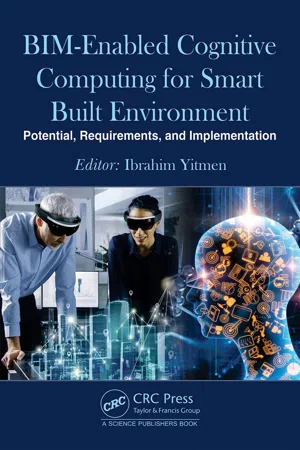
BIM-enabled Cognitive Computing for Smart Built Environment
Potential, Requirements, and Implementation
- 220 pages
- English
- ePUB (mobile friendly)
- Available on iOS & Android
BIM-enabled Cognitive Computing for Smart Built Environment
Potential, Requirements, and Implementation
About this book
The book provides knowledge in the Building Information Model (BIM)-enabled cognitive computing methods for smart built environment involving cognitive network capabilities for smart buildings, integrating Augmented Reality/Mixed Reality in cognitive building concepts, cognitive Internet of Things (CIoT) for smart cities, Artificial Intelligence applications for cognitive cities, and cognitive smart cities using big data and machine learning. It focuses on the potential, requirements and implementation of CIoT paradigm to buildings, Artificial Intelligence techniques, reasoning, and Augmented Reality/Mixed Reality in cognitive building concepts, the concept of cognitive smart cities in its complexity, heterogeneity, and scope, and the challenge of utilizing the big data generated by smart cities from a machine learning perspective. The book comprises BIM-based and data-analytic research on cognitive IoT for smart buildings and cognitive cities using big data and machine learning as complex and dynamic systems. It presents applied theoretical contributions fostering a better understanding of such systems and the synergistic relationships between the motivating physical and informational settings. It reviews ongoing development of BIM-based and data science technologies for the processing, analysis, management, modeling, and simulation of big and context data and the associated applicability to cognitive systems that will advance different aspects of future cognitive cities. The book also analyses the required material to inform pertinent research communities of the state-of-the-art research and the latest development in the area of cognitive smart cities development, as well as a valuable reference for planners, designers, strategists, and ICT experts who are working towards the development and implementation of CIoT based on big data analytics and context–aware computing.
Frequently asked questions
- Essential is ideal for learners and professionals who enjoy exploring a wide range of subjects. Access the Essential Library with 800,000+ trusted titles and best-sellers across business, personal growth, and the humanities. Includes unlimited reading time and Standard Read Aloud voice.
- Complete: Perfect for advanced learners and researchers needing full, unrestricted access. Unlock 1.4M+ books across hundreds of subjects, including academic and specialized titles. The Complete Plan also includes advanced features like Premium Read Aloud and Research Assistant.
Please note we cannot support devices running on iOS 13 and Android 7 or earlier. Learn more about using the app.
Information
CHAPTER 1
Overview of Cyber-Physical Systems and Enabling Technologies in Cognitive Computing for Smart Built Environment
1.1 Introduction
1.2 Cyber-Physical Systems (CPSs)
1.2.1 CPS 5C Level Architecture

- The level of smart connections: Gathering precise and reliable data from different components and sections is the primary phase in developing a CPS application, which might be measured directly by sensors or acquired from manufacturing systems. It comprises ‘plug & play’ devices, independent communications, and sensor networks. Data acquiring and transmission within selected devices utilizing uniform procedures have to be as forthright as possible for this level to operate under expectations.
- The level of data-to-information conversion: There exist services, tools, and procedures built on data stored at Level 1, that are being retrieved and utilized for predictions, correlations, statistics, and management to support decision making.
- The cyber level: It performs as a central data hub within this pile. The primary model for this level is the Digital Twin (DT), digital representation of an object that exists or will exist in the physical world. When the data stored at the level of smart connections and analyzed at the data to information conversion level is located in the framework of the advanced data mining model, interconnections, simulations, and analytics turn out to be actual and practical.
- The cognition level: Learning can proceed beyond and utilize artificial intelligence (AI) technologies to make progressive decisions, diagnostics, and machine learning (ML). It is presumed that a majority of information, which cannot be handled using conventional approaches, will require analyzing with machine learning as the scope and variety of data would be very big for the analysis to be processed manually by people writing algorithms.
- The configuration level: It is the feedback from cyberspace to physical space, which functions as managerial control to make machines self-adaptive and self-configuring. This can lead to autonomous, smart, self-learned, and automatic configuration of cyber systems that can intelligently respond to environmental changes and user requirements.
1.2.2 CPSs in AEC Industry
- The various technologies, which are known, accepted, and implemented in construction projects like BIM, reality capturing technologies, portable devices, GPS, and UAVs, are currently utilized in different construction progressions and have the potential to encourage future higher levels of CPSs implementation.
- Trendy technologies that currently are not fully used. However, they can take CPSs applications to the next level, such as IoT, extended reality (XR) technologies (virtual reality (VR)/augmented reality (AR)/mixed reality (MR)), robotics, machine learning (ML), artificial intelligence (AI), etc.
Table of contents
- Cover
- Title Page
- Copyright Page
- Preface
- Acknowledgements
- About the Editor
- List of Contributors
- List of Figures
- List of Tables
- Introduction
- Contents
- 1. Overview of Cyber-Physical Systems and Enabling Technologies in Cognitive Computing for Smart Built Environment
- 2. Towards a Digital Twin-based Smart Built Environment
- 3. BIM-IoT-integrated Architectures as the Backbone of Cognitive Buildings: Current State and Future Directions
- 4. The Evolution of Building Information Model: Cognitive Technologies Integration for Digital Twin Procreation
- 5. The Integration of Building Information Modeling (BIM) and Immersive Technologies (ImTech) for Digital Twin Implementation in the AECO/FM Industry
- 6. Smart Maintenance Services for Buildings with Digital Twins and Augmented Reality
- 7. Blockchain: Technologies for Facilitating Cyber-Physical Security in Smart Built Environment
- 8. eLUX: The Case Study of Cognitive Building in the Smart Campus at the University of Brescia
- Index